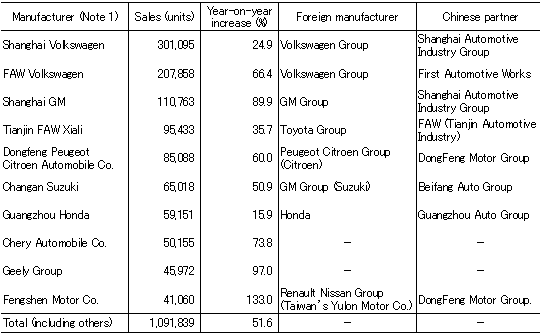Contrary to the pessimism regarding China's automobile industry prior to the nation's entry into the World Trade Organization, demand is rising and supply capacity is expanding sharply thanks to the active entry of foreign automakers, including those from Japan. Against such a backdrop, China is emerging as a major auto manufacturer. However, auto production in China has yet to gain international competitiveness in terms of cost and quality, for both Chinese firms, obviously, and even also for foreign automakers. Each firm will have to beef up management - not just to prepare for increased competition with imported cars, once import tariffs are slashed, but also to aim to export cars from China in the future.
There are no bounds to the advances of China's auto industry. Auto production in 2002, the first year of China's entry into the WTO, came to 3.25 million units (of which passenger cars accounted for 1.09 million units), a near 40 percent rise on the previous year. The trend is continuing this year, and annual output is certain to top 4 million units. As a result, China's auto production is expected to jump from eighth in the world (in 2001) to fourth, surpassing France and coming up behind the United States, Japan and Germany. The day China surpasses the U.S. and becomes the world's top automaker may not be too far off.
However, when assessing the real strength of China's auto industry, we must not forget that its growth is supported by the entry of the world's top carmakers into the local market. In fact, most of the cars manufactured in China, especially passenger cars, are produced by joint ventures between foreign firms and Chinese companies (chart). The strength of Chinese automakers still greatly lags behind that of their global counterparts, and in joint ventures, they have no choice but to fully depend on foreign firms for everything from research and development to main parts. Once such costs as technological licensing fees, profit, and the import of intermediate parts paid to foreign companies are taken into consideration, it becomes obvious that the value added by the auto industry that is counted into China's gross national product is much less than sales.
The main aim of foreign carmakers entering the Chinese market is not so much cost reduction as the desire to enter the local market. In principle, automakers can access the Chinese market by producing vehicles overseas, such as in the home country, and then exporting to China. However, they have no choice but to resort to local production because of such trade barriers as import tariffs. At present, even though the tariff rates on automobiles have been cut, they are still high at about 40 percent (for passenger cars). In such a situation, where the domestic auto market is cut off from the international market through these tariffs so that competition is restricted, foreign carmakers with local production bases are all making huge profits.
Guangzhou Honda, a joint venture of Honda Motor Co., is doing especially well. The firm is selling locally produced New Accords at ¥3.6 million - about 60 percent higher than its selling price in Japan - and compared to last year's sales of 13.7 billion yuan (1 yuan = approx. ¥15), it logged pretax profits of some 5 billion yuan; a profit rate of 36 percent. However, just because a business was profitable in the past is no guarantee that it will remain profitable in the future. This is due to the fact that when entering the WTO, China pledged to reduce its import tariffs on cars to 25 percent by mid-2006, and competition between "domestic" cars and "imported" cars is expected to intensify. In addition, with each automaker vigorously pursuing increases in production, there may be a production glut, leading to further downward pressure on prices.
In addition to selling locally in China, Honda and other foreign automakers envision utilizing China as a production base for export. This is because foreign companies specializing in the production of cars for export are granted preferential tax treatments and permission to have more than 50 percent ownership. In addition, the cost of production is expected to fall sharply, as a result of expansion of production scale and rising productivity. However, while domestic sales are protected by China's import tariffs, exports from China will, conversely, come up against the import tariffs of other countries. Furthermore, the international competitiveness of cars made in China depends on wage levels in China and the yuan's exchange rate. When drawing up production and export plans, the fact that both wages and the exchange rate will rise with the increase in China's labor productivity must be fully taken into account.
China has adopted an industrial policy of, "swapping the domestic market for foreign technology," and the auto industry was a model of this. However, judging from the results, foreign firms have completely occupied China's market, but the country has yet to gain key technology. China's dependence on foreign companies has become increasingly conspicuous with its entry into the WTO. In the future, if foreign firms are allowed 100 percent ownership, the significance of Chinese firms will be further thrown into doubt. While the future of foreign automakers in China is not exactly rosy, prospects for Chinese firms could be even worse. China's domestic car manufacturers may disappear totally before China becomes the world's top automobile producer.
| Chart : | Passenger car sales by manufacturer (2002) |
 | |
| (Note 1) | Except Chery and Geely, all listed carmakers are joint ventures with foreign firms. Source: Various media reports |
| (Source) | Various media reports |


